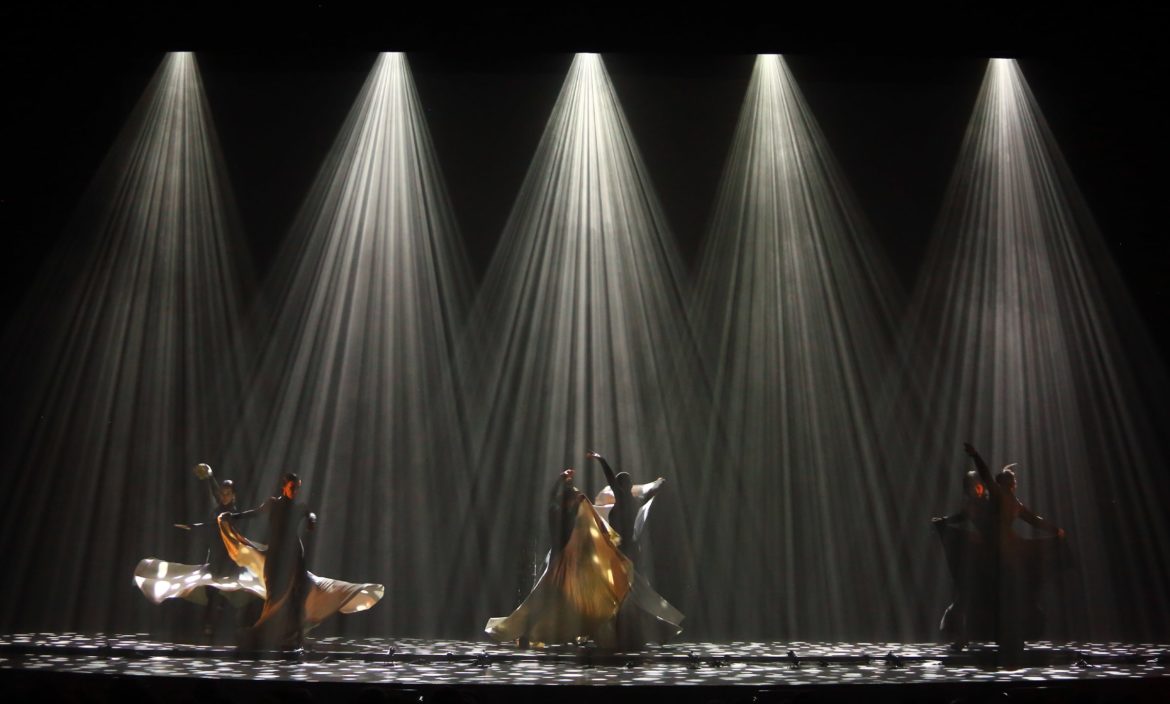To truly understand flamenco in all its nuances, you either have to be born into it or possess a lifelong passion for this captivating art form. Although it isn’t always possible to experience this centuries old gypsy dance and its music in an authentic Andalucian setting, we are fortunate to have the annual Flamenco Festival at Sadler’s Wells, bringing the best home-grown talents from Spain to London with their riveting rhythms and styles, ranging from the traditional to the contemporary. And when Sara Baras opens the festival, audiences expect no less than an electrifying performance.
A fitting start to Sombras (“Shadows’) was a striking silhouette of dancers in stylised poses, followed by a solo from Baras dancing to the ‘Farruca’, alternating slow moves with bursts of rapid footwork. Those who managed to take their eyes off her for a moment would have noticed multiple shadows of her dancing cast against the background. Then came a poignant moment when Israel Fernández sang the Farruca in a deep and haunting ‘cante jondo’ style while Baras improvised her steps. Against a pitch-black background, the spotlight was on the connection between singer and dancer, between Baras and her shadow, ‘La Farruca’.
Those familiar with Baras’s style will recognise the trademark ‘windmill’ arm rotations and fast and furious zapateado (footwork), alongside her undeniable aura and stage presence. In fact, many years ago it was her sleek rendition of the Farruca, traditionally a male dance, that broke ground. Donning a fitted top, vest and high-waisted trousers, her sheer power and razor-sharp accents could put a matador to shame and cause a raging bull to pause in its tracks. This is what earned Sara Baras recognition in the realm of contemporary flamenco. And while she continues to innovate and reinvent her repertoire, undeniably, she redefined the Farruca. Twenty years on, she’s paying homage to what has now become part of her persona.

Baras’s more lyrical style came through in pieces created for her troupe, as in Zapateado, where the women wore costumes with multi-layered frills, flicking their fans to the lilting accompaniment of the flute. Another reference to traditional flamenco was the use of wooden canes in Martinete, with its syncopated footwork and canes pounding the floor to mimic the sounds made by gypsy blacksmiths. One of the show’s highlights was the Mariana number, where the Bata de Cola (skirt with long ruffled train) and manton (shawls) showed off the romantic, feminine side of flamenco.
A talented ensemble of musicians and singers elevated the performances to another level. Singers Rubio de Pruna and Israel Fernández couldn’t have been more contrasting, but it was Israel’s raspy, high-pitched voice that woke up the ‘duende’ (deep emotion) in both the performers and the audience. The two guitarists, Keko Baldomero (also the show’s musical director and composer) and Andrés Martínez, were accompanied by percussionists Antonio Suárez and Manuel Muñoz ‘Pájaro’. Diego Villegas played the harmonica and flute with ease, but it was his skill in shadowing Baras’s rhythmic footwork on the saxophone that really blew us all away.
Read our review of Flamenco Workshop with Sara Baras Company
An honorary mention should go to the lighting, which played a major role in creating the mood and ‘shadow’ effect for each dance. A kaleidoscope of clever effects, in one sequence beaming down like laser threads that scattered fairy lights across the floor. The work of Málaga-based painter-garabatista Andrés Mérida was also featured in giant background panels.
All in all, Sombras will be remembered not just for Sara Baras’s sharp, zingy choreography and fashionable costumes, but also for its visually stunning production. And as all flamenco artists do, she paid homage to the past, returned to traditions in the style she is world-renowned for. May the shadow of ‘Farruca’ always stay with her.
Reviewed at Sadler’s Wells on 5th of July


